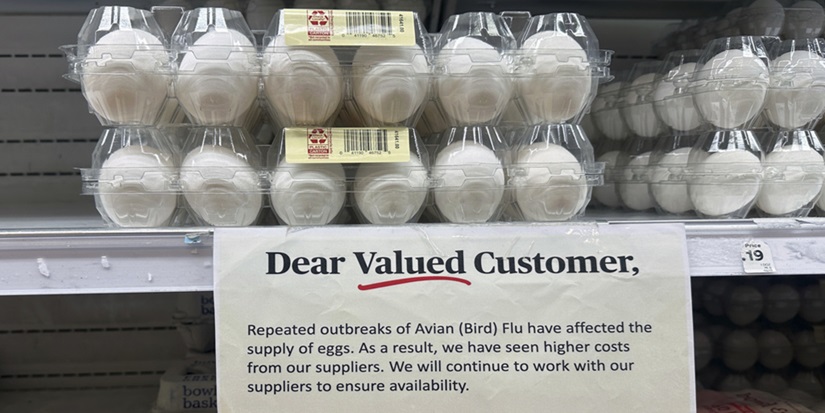When someone mentions inflation, economists think about indexes. We have many: CPI, PCE, HICP, plus hundreds of sub-indexes.
Normal people, however, measure inflation by the prices they see in their routine shopping. This gives frequently purchased items more influence on inflation perceptions.
Eggs, for example, are a tiny sliver of total consumer spending. But price increases stand out because so many middle-class households buy them often. Media picks up on the widespread anger, further amplifying it.
Just a few months ago, inflation was stabilizing enough for the Federal Reserve to start cutting rates. Now every trip to the grocery store reminds people that inflation is still affecting the things they buy most often.
I don’t think this is over. It may only be getting started.
Cows with the Flu
Egg prices are rising so much mainly due to the H5 bird flu outbreak. The virus spreads easily within large chicken flocks, then wild birds spread it from one flock to the next.
Millions of egg-laying hens have been slaughtered. Rebuilding those flocks takes a long time. Meanwhile, we have egg shortages.
But it gets worse.
Bird flu doesn’t only affect birds. Mammals can get it, too, if they eat infected birds or if they are in a place contaminated with the virus.
Last year, there were isolated reports of the virus appearing in cattle. This year, those reports are, well, more than isolated.
An Ohio State University report says cows usually have only mild symptoms, but for some reason the infection is usually localized in their mammary glands. That’s where milk comes from.
Pasteurization seems to kill the virus so the threat to humans appears low. Those who drink raw milk could be vulnerable.
But there’s still a lot we don’t know. Just last week, testing found a new bird flu variant at an Arizona dairy farm. It is now under quarantine.
Will quarantine stop the virus? We’ll see. But it’s already stopped that farm, at least, from selling any milk.
For inflation perceptions, milk is even more important than eggs.
A Milky Problem
If more dairy farms have to be quarantined—or worse, have to cull their herds—it will certainly reduce US milk supply and raise prices. But that’s not the only challenge.
Dairy cows have to be milked frequently. Modern equipment helps but it’s still a labor-intensive process.
Who does this labor? Mostly immigrants… and often the undocumented ones who are targets of the Trump administration’s immigration crackdown.
This is a big problem for the dairy industry. Fruit and vegetable growers can bring in seasonal workers at harvest time under the H-2A visa program. There’s no such program for dairy farms, which need workers not just seasonally but year-round.
Cows require milking 2–3 times a day, every day of the year. See the problem?
Farmers are caught in the middle. A spokesman for the Wisconsin Farm Bureau Federation told the Financial Times, “We support the deportation of criminals, but we need a secure labor force for Wisconsin.”
That same FT report quoted several Wisconsin dairy farmers. One put it starkly:
“If there’s no immigrant labor, there’s no milk, no cheese, no butter, no ice cream. We’ll all have to go vegan.”
Another farm owner agreed:
“Let’s say the people in Washington could wave a magic wand and make all these [immigrants] disappear—you’d have dead cows piling up outside the dairy farms. The industry would die a horrible death within 48 hours. Because no one would be there to slaughter the cows, let alone milk them.”
He’s not exaggerating. Modern dairy cows have been bred to produce far more milk than a single calf can drink. If not milked, a lactating cow will quickly get sick and can even die.
Could native-born Americans milk the cows? Sure. But a bunch of them would have to move to rural Wisconsin and other remote places for relatively low-wage jobs.
Farmers could raise wages to attract legal labor. That, however, would mean higher milk prices, plus all the other foods made from milk products.
Obviously, illegal immigration is a problem we must solve. But if the solution deprives the dairy industry of its labor supply, milk supplies will drop, and prices will rise.
And in that environment, it won’t be just milk. For example, meat packing plants depend heavily on immigrants, too.
Between bird flu and labor supply, food prices face two major inflation threats. Either would be bad on its own. We could see both this year…. and we haven’t even talked about the brewing trade war’s potential effects on US agriculture.
Will the Federal Reserve cut interest rates while food inflation is in the headlines? Probably not. It might even raise rates.
Which makes “higher for longer” a good bet, for both inflation and interest rates.
This will have consequences.
See you at the top,





